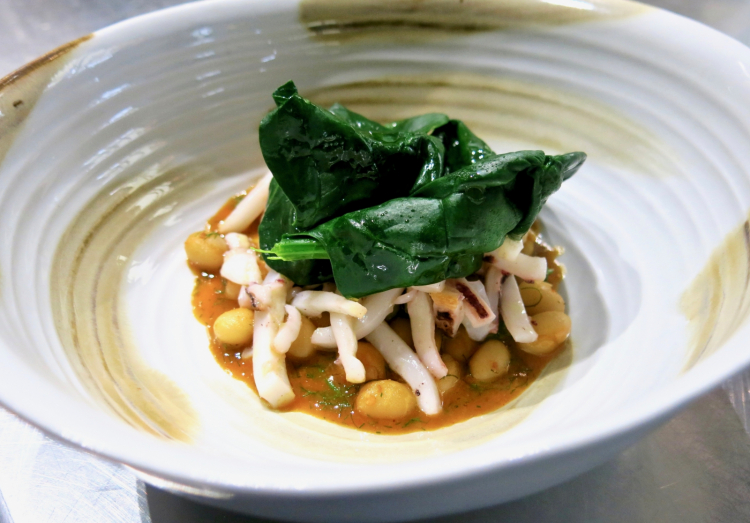After the great symphonies of culinary experimentation played from the small stage of Rino, Giovanni Passerini, in his new restaurant named after him (read the review by Tokyo Cervigni for Guida identità Golose 2017), allows himself more space, changes orchestra and instruments so as to play more classic melodies, though their vibrating soul is still imbued with rock.
With Rino, his first restaurant, which was born in 2010 and died four years later, the chef managed to express the irreverent strength of his both exuberant and refined creativity, leaving an important mark in the history of the Parisian bistronomic revolution. Today, while this approach to restaurant offer has been brought to an extreme, Passerini has sensed the time has come to take a step back, so as to offer Parisians a more “comfortable”, more rustic cuisine, that would put the best Italian tradition back to the top.
These different choices find their place in two separate moments of his personal journey and that of the Parisian restaurant industry. Both are right choices taken at the right time: in 2011 French guide
Le Fooding nominated
Rino the "
meilleur bistrot d'auteur", acknowledging it as one of the crown jewels in the capital’s
bistronomie; last November, only six months after opening
Passerini,
Giovanni was nominated "
meilleur chef" of the year and has already become a new icon in the rediscovered Italian neoclassicism.
He says: «Let’s leave young people like Michele [Farnesi] or Simone [Tondo] the chance to be rock and roll. At forty, I can take on the responsibility of an accomplished, impeccable tradition that is now hard to find even in Italy». Between the walls of the restaurant, with a contemporary decor, a strictly traditional Italian cuisine coexists with classics French roasts and a few dishes vaguely recalling Rino. «I’m still in the middle of a deciding phase. I must understand what the future will be like. Can French and Italian coexist? Modern and creative? Can Roman-style tripe cohabit with a seaweed broth with tortellini filled with gorgonzola and sea urchins?».

«My greatest talent is that I understand what people want to eat. Do they want carbonara? Let’s make it! Do they want pigeon to be cooked longer? Let’s do it! Of course it requires some effort, chefs must step aside, in a way. But we’re restaurateurs, we must refresh people, we cannot always expect clients to be those who must understand us».
Together with his wife
Justine, who’s a partner in the restaurant, the chef created a place where he can satisfy the desire for a comfortable place, the desire to choose and the desire for a human warmth that is harder and harder to find in Paris. While in the past
Passerini’s attention was mainly focused on the idea of a culinary journey, today he goes beyond, embracing the food experience as a whole and pampering guests, transferring the concept of rural tavern into a new urban dimension that can offer a non banal authenticity. Having abandoned the tasting menu, today’s menu ranges from small nibbles that disappear in a few bites, so as to increase salivation, to pieces of meat or an entire fish that can satiate the entire table, including the inevitable pasta, with the fresh pasta coming straight from the adjacent
Pastificio Passerini.
«Today my ambition is to become a great restaurateur». The evolution process is still in progress, it requires the chef a strong capacity to put his ego aside and listen to the guests’ needs. What’s guiding him is a precise image, that of guests sitting at a table and rubbing their hands foretasting one of the classics in Passerini’s menu, such as supplì, montanare, gricia pasta or Roman-style tripe. The idea of hearing aficionados exclaim: «Let’s go and have tripe at Giovanni’s!».
«My greatest talent is that I understand what people want to eat. Do they want carbonara? Let’s make it! Do they want pigeon to be cooked longer? Let’s do it! Of course it requires some effort, chefs must step aside, in a way. But we’re restaurateurs, we must refresh people, we cannot always expect clients to be those who must understand us».
Having got over the stress and tiredness that came with the works before opening the restaurant,
Passerini is thinking of the future already, when he’ll serve triumphant dishes such as
Il peggio dell’agnello, a series of courses based on the entrails and less noble parts of the lamb, which should end with a lamb head, or
Gran fritto all’italiana, which is also designed as a feast including multiple [fried] courses.
«Now the tiredness from opening is behind me, I have simplified my life. I now want it to get complicated. Rino was like a FIAT Cinquecento with the engine of a Ferrari. What I miss here is pushing the restaurant to its limit, use my ingenuity to reach a goal. I like taking everything to its limit, so as to go beyond». No dish from Rino found place in his new menu: there’s been a clear break with the past, which for Giovanni is the best way to pay homage to it and then evolve freely. And though some may miss it, people like Passerini’s new dimension.